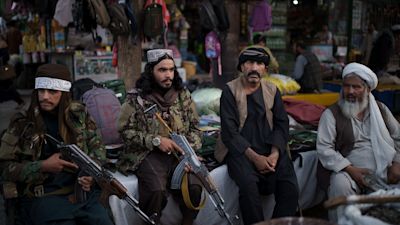Insight
The remarkable story of what happened in Afghanistan and Iraq after 9/11

By the evening of September 12, 2001, we had made it to Baghdad. But we were 18 months early.
My editor at ITV News had - not unreasonably - feared a far-reaching and immediate response to the 9/11 attacks from President George Bush. Retaliatory strikes against all America’s enemies.
“You’re either with us, or against us,” had come the warning from the White House.
Saddam Hussein may have been on the back burner since Gulf War One, but all the world’s big news organisations still had a Baghdad bureau because they knew he was unfinished business.
By the time Saddam came into Mr Bush’s crosshairs, in March 2003, the Americans had already achieved a stunning victory in Afghanistan. Special forces soldiers had galvanised the Northern Alliance and together they had routed the Taliban from Kabul.
The Taliban retreated to their stronghold in Kandahar, where the SAS were part of the assault group that defeated them as they made a last stand at an old fort.
Then the Americans lost interest in Afghanistan. And as we now know, the Taliban were weeds that hadn’t quite been taken out by the roots.
Perhaps the victory in Afghanistan wasn’t demonstrative or dramatic enough for Mr Bush. He wanted ‘shock and awe,’ and needed another punch bag.
Step forward Saddam Hussein. I remember all too well high-speed chases through the deserts around Baghdad.
We were following UN weapons inspectors as they visited various sites the Americans had suggested were busy and sinister.
They all looked to us like they’d been mothballed years ago - because they had been!
Colin Powell told the UN Security Council that the Iraqis had put large awnings over missile test beds in an effort to hide them from spy satellites.
All we could make out were decaying fragments of corrugated iron that had clearly been erected to provide a little shade to those who had worked on the sites years ago.
President Bush was going to invade Iraq whatever the UN decided. The country had been on ice since sanctions were imposed in 1991. Those economic tariffs had been extremely effective for it was indeed the land that time forgot.
I remember crossing the border from Jordan into Iraq in 2002 and noticing a Teasmade in the Iraqi duty free shop.
It looked just like the one my parents had beside their bed in the late 1970s.
There were those who could dodge sanctions of course, and outside the duty free shop that day, on a low loader, was a brand new Rolls-Royce convertible.
It was painted Lady Penelope pink, the colour favoured by Saddam’s terrifying elder son Uday. This was the latest addition to his fleet of Rollers.
By the time the Second Gulf War began in March 2003 I had naively decided that nothing could be worse for Iraq than the rule of Saddam Hussein.
(Note: the Middle East is one of those places where the more you find out the less you know. One irrefutable truth is that, no matter how bad things get, don’t imagine they can’t get even worse.)
The Americans reached Baghdad three weeks later. British TV networks had stayed in the city. Most American ones had fled.
The ITV News team was the first to greet the Marines because we went out to find them.
Our drive took us past jubilant Iraqis who welcomed the Americans as conquering heroes.
I shook the hand of one US soldier and told him, “Welcome to Baghdad.”
We had no way of knowing that the Fall of Baghdad, on April 9, 2003, would be the high water mark of US involvement in Iraq.
The puritans of Republicanism banished the Baathists and with a stroke of the pen any Iraqi who had helped secure or run the country was an undesirable.
Chaos followed.
The rise of Iran; the rise of Islamic State; the civil war in Syria; the collapse of Lebanon, they can all be traced back to what the Americans did and didn’t do in Iraq.
I was back in Baghdad early last year. I’m delighted to report the city looks far better than it has for a long while.
There was a time in 2004 and 2005 when the threat of bombings or kidnappings was so great we couldn’t leave our hotel. Now things are looking up. Fingers crossed for Baghdad.
Twenty years after 9/11, I have just witnessed the Fall of Kabul to the Taliban.
We stayed in what we knew would be Taliban-held Kabul because, as was the case in Baghdad back in 2003, it felt like the right thing to do.
Of course it was risky and stressful. But it was history.
Cameraman Sean Swan and producer Lutfi Abu-Aun have been wonderful companions in many tight spots before.
For all of us, watching Taliban patrols roam the streets of Kabul the morning after they took the city, was surreal and sinister.
Farewell to Kabul: 'The biggest self-inflicted humiliation ever suffered by the West' - Watch John Irvine's report
There wasn’t a cloud in the sky but Kabul felt gloomy indeed. Everyone thought they knew what the restoration of Taliban rule meant.
If they weren't old enough, they had lived through it before, if they weren’t old enough, their parents had told them what it was like.
Fear was everywhere. Those who weren’t terrified were just depressed.
In a way, Baghdad and Kabul are twin cities that have met different fates.
Baghdad - a place that had nothing to do with 9/11 – is on the up. Kabul – a place that had everything to do with 9/11 – is in decline. Because the allies of the guilty are back in charge.